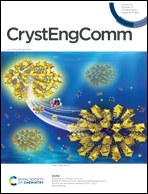Synthesis of cobalt-doped V2O3 with a hierarchical yolk–shell structure for high-performance lithium-ion batteries†
Abstract
Transition metal oxides as electrode materials for LIBs are constrained by tremendous volume changes, self-aggregation and poor conductivity. Therefore, it is extremely imperative and necessary to develop a new electrode material with high capacity and long-term cycles. In this paper, yolk–shell Co-V2O3-24 nanospheres assembled with nanosheets were designed and synthesized through a one-step solvothermal treatment and calcination process. The results show that the anion plays a significant role in morphology induction during the solvothermal reactions. As an anode material, Co-V2O3-24 displayed an outstanding reversible specific capacity of 986.2 mA h g−1 at 0.5 A g−1 after 630 cycles with a high capacity retention rate. Even when tested at 5 A g−1 after 2200 cycles, the specific capacity of 457.6 mA h g−1 can be retained, which indicates that Co-V2O3-24 has excellent rate performance and cycle stability. The outstanding lithium storage properties mainly benefit from the novel 3D hierarchical structure, Co doping and abundant electrochemical active sites.



 Please wait while we load your content...
Please wait while we load your content...